#Godzilla vs Kong Sequel
Explore tagged Tumblr posts
Text
Godzilla x Kong: The New Empire | Official Trailer 2 Unleashed
Godzilla x Kong: The New Empire | Official Trailer 2 Unleashed Prepare yourself for the most monumental battle this year with the release of “Godzilla x Kong: The New Empire” Official Trailer 2. The legendary rivalry escalates as these iconic Titans face off once again, not just against each other but against an unseen threat that could alter the course of nature and humanity forever. Set to hit…

View On WordPress
#Adam Wingard#Beyond Monsterverse#Blockbuster Film#Cinematic Adventure#Cinematic Universe#Dan Stevens#Epic Battle#Godzilla vs Kong Sequel#Godzilla x Kong: The New Empire#Guardians of Nature#IMAX Experience#Legendary Pictures#Legendary Titans#March 29 Release#Monster Movie#Monsterverse#Mythic Battles#Nature Protectors#New Empire 2024#Official Trailer#rebecca hall#Skull Island#Titan Origins#Titan Showdown#Warner Bros
2 notes
·
View notes
Text
I'm...I'M NOT ENTIRELY FUCKING READY FOR THIS.
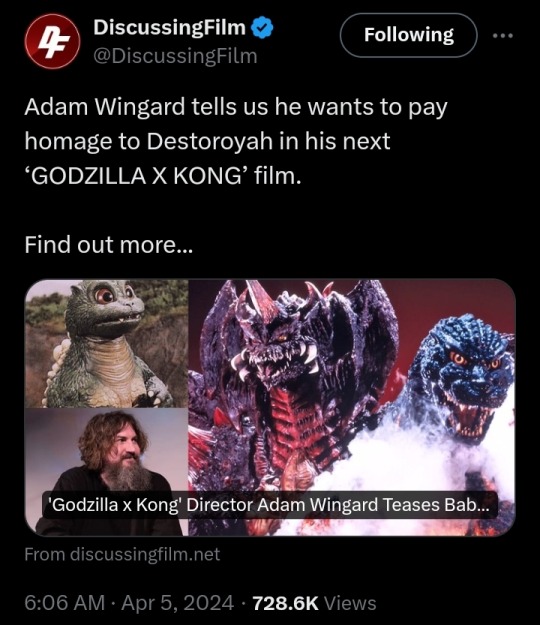

Link:
https://x.com/DiscussingFilm/status/1776008584930775491
#PLEASE HELP GUYS#ADAM WINGARD'S GONNA PLAN A SEQUEL#AND I'M SENSITIVE IN EMOTIONAL MOVIES LIKE GODZILLA VS DESTOROYAH#AND I WANT HIM TO BE TEAM UP WITH KONG SHIMO SUKO MOTHRA AND RODAN PLEASE#BECAUSE THEY'RE NOW ON MY CHARTS#RAAAAAAAHHHHHH DESTOROYAH IS GONNA BE A BLAST#godzilla#mothra#kong#shimo#suko#rodan#monsterverse#kaiju#godzilla king of the monsters#godzilla kotm#godzilla x kong: the new empire#gxk#adam wingard#I REALLY REALLY WANT TO SEE GODZILLA JUNIOR
281 notes
·
View notes
Note
do u perhaps have any advice/notes on how to write a Deaf character, especially on how to write them signing?
Writing Notes: Deaf Characters
Deaf
The word “deaf” describes a person with profound or complete hearing loss. It is important to understand that many people do not consider being deaf or having hearing loss as a disability. Instead, deafness is often considered a culture.
“Deaf” and “hard of hearing” are the terms recommended by the World Federation of the Deaf and The National Association of the Deaf. Many people in the Deaf community prefer the use of a lowercase “d” to refer to audiological status and the use of a capital “D” when referring to the culture and community of Deaf people. Some people with mild to moderate hearing loss may affiliate themselves with the Deaf community and prefer to be referred to as “deaf” instead of “hard of hearing.” Alternatively, some who are profoundly deaf may prefer the term “hard of hearing.”
NCDJ Recommendation: “Deaf” or “hard of hearing” are the preferred terms. Uppercase when referring to the “Deaf” community and lowercase when referring to the condition. Avoid using “hearing impaired” or “partial” or “partially” in reference to deafness or hearing loss unless people use those terms for themselves.
When possible, ask if a person or group uses identity-first language (deaf students) or person-first language (students who are deaf). However, The National Association of the Deaf supports the identity-first approach.
When quoting or paraphrasing a person who has signed their responses, it’s appropriate on first reference to indicate that the responses were signed. It’s acceptable to use the word “said” in subsequent references.
AP style: The stylebook uses “deaf” to describe a person with total hearing loss and “partially deaf” or “partial hearing loss” for others. It calls for use of a lower case “d” in all usages.
The Portrayal of Deafness in Media
Some examples you can use, and do further research on, as a guide (also to learn from and avoid what are considered problematic representations in media):
A Quiet Place and sequels: Post-apocalyptic thrillers in which monsters with highly-advanced hearing invade America. The main characters are a family who all know American Sign Language, owing to their deaf eldest daughter (played by deaf actress Millicent Simmonds), allowing them to communicate without drawing the monsters' attention, and most of the dialogue (especially in the first film) is in ASL. Static from her hearing aid also proves to be a powerful weapon against the monsters.
Baby Driver: Features a hearing protagonist with tinnitus (Ansel Elgort) who is a getaway driver for a gang and has a deaf foster father (CJ Jones).
Godzilla vs. Kong: One of the main human characters is a deaf girl named Jia, played by deaf actress Kaylee Hottle. She is said to be the last of the Iwi people, the natives of Skull Island, and she has a strong emotional bond with Kong, as both of them are the last of their kind. Past incarnations of Kong typically formed strong emotional connections - sometimes ambiguously sexual ones - with white American women, so this is also the first time the most important human to Kong has been a native of his own island. She also teaches Kong sign language.
Hawkeye: As in the comics, Clint suffers from hearing loss due to his superhero endeavors taking a toll on him. The series also features a prominent supporting character who is deaf (Echo), played by deaf actress Alaqua Cox.
Sound of Metal: An American drama starring hearing actor Riz Ahmed as a metal drummer losing his hearing and working at a school for the deaf.
Switched at Birth (2011) features several deaf characters who are able to sign fluently. The show portrays how they adjust to life and their everyday experiences with being deaf and how hearing people react to them.
There Will Be Blood: H.W. is left deaf after a blast at the oil field.
The entry below focuses on films made by American and foreign filmmakers who have little or no special interest in or knowledge about deaf people or Deaf communities. Casting hearing actors to portray deaf characters is unfortunately common. Because neither the filmmakers, the expected audiences, nor the actors know anything about d/Deaf people, inauthenticities are widespread. These problems are only slightly improved by casting a Deaf actor: Deaf actors can portray authentic use of a sign language but are often limited by the script, the director, and the editing process. Therefore, while the signing community commends the casting of Deaf actors, the discussion here focuses on the deaf characters themselves and reasons for their inclusion in the story. In the following, the actors are labeled either “D” for Deaf or “h” for hearing. If there is no label, the actor’s status is unknown.
Deaf Characters and Sign Language for Intrigue. Thrillers with deaf characters typically put a deaf woman in peril. In Hear No Evil (1993), Jillian (Marlee Matlin d) has been learning from her hearing boyfriend which mechanical devices cause ear-splitting noises. When she is pursued by a would-be murderer, she takes advantage of a fire alarm, a sprinkler system, and a stereo turned full blast to mask the sounds of her movements as she attempts to hide. In Orphan (2009) a family with two children, one of them deaf (Aryana Engineer h), adopts an orphan who turns out to be a murderous psychopath. When this “orphan” cleverly steals the deaf girl’s hearing aid before launching the climactic killing spree, we gasp in horror as the deaf girl negotiates the house unable to hear just where her mother or the murderer are. Suspect (1987) has a major deaf character, a mentally ill transient (Liam Neeson h) who has lost his hearing during the Viet Nam war and is accused of murder, but the film focuses on the efforts of his court-appointed attorney, who first must realize that he is deaf, then piece the case together with minimal help from him. (His treatment by the police will be regarded as unsettling and quite authentic by many deaf viewers.) In a departure from the usual use of the deaf character in thrillers, The River Wild (1996) has hearing characters communicating surreptitiously in ASL after they are taken hostage. A brief glimpse of a Deaf father (Victor H. Galloway d) at the beginning of the movie shows where they learned to sign.
Heightened Sensory Powers. The myth that deaf (and blind) people have heightened sensory perception sometimes prompts writers and filmmakers to provide their deaf characters with supernatural powers. After Image (2001) presents Laura (Terrylene d), a young deaf woman whose visions and strange dreams enable her to discern clues to crimes. What the Bleep Do We Know? (2004) is a hybrid of narrative and documentary filmmaking, with Amanda (Marlee Matlin d) simultaneously experiencing different planes of existence as she struggles with the existential angst of her life.
Writing Notes: Sign(ed) Languages
Sign(ed) Languages are languages which primarily function non-verbally through visual signals, generally invented for the use of the deaf to communicate. As the name indicates, the primary means of communication is generally signs made with the hands in front of the body. However, most sign languages include facial expressions and some, such as Japanese Sign Language, include mouthing as part of their mechanics. It is important to recognize that while almost every community with a spoken language also has a signed language, the signed language used is related more to the geographical region than to the spoken language. For example, English is the primary language of the United States, Canada, UK, Australia and New Zealand, but the US and (Anglophone) Canada use ASL note , the UK uses BSL, and Australia and New Zealand use Auslan and NZSL respectively - all different languages with distinct signs and grammar.
One important aspect of Signed Languages is that they are, as a rule, fully-formed languages with their own grammar and words. They are not pantomime nor do they necessarily follow the grammar of the spoken/verbal language of the region. Some signs are iconic, or resemble what they speak of, much like how some spoken words are onomatopoeic, but most signs are abstractions of iconic signs or completely original. The grammar itself frequently differs greatly in part due to the spatial aspects of signs and the ability to convey information non-sequentially. For example, within ASL, it is common to establish specific people in a conversation at spatial locations and later use signs moving from location to the other rather than having to reestablish identities or use pronouns. Similarly, since both hands and the face can be used, multiple pieces of information can be encoded into a single sign. For example, a sentence like "I drove from Jane to John and I enjoyed it" can be conveyed in a single sign if Jane and John have already been previously established in the conversation. And, before you ask, most signs convey individual words. There is finger-spelling (you're familiar with that from The Miracle Worker, it's what Annie shows Helen to communicate), but it's inefficient (especially with big words like "inefficient"), and not all signers are necessarily fluent in it because it requires them to depict, letter by letter, words that are not from their native language — specifically, words from the spoken/verbal language of the region.
It is worth noting that Signed Language, while non-verbal, is not necessarily quiet. Even deaf users typically make sounds while signing and it is not infrequent for a very low-pitched grunt to be used to catch someone's attention via the vibrations.
As an anthropological note, it is worth considering that many communities and cultures define themselves by their language, and the deaf are no exception. The word "Deaf" is often capitalized when indicating the non-hearing culture, or membership of same. Though there are always exceptions, most Deaf individuals do not consider their lack of hearing to be a drawback and are proud of the community their condition allows them access to.
For a number of reasons, including religious, eugenics and association with Native Americans (e.g. Plains Indian Sign Language) and other "savages", the oralist movement sought to eliminate Sign in an attempt at normalization and mainstreaming. There were actually laws against using Sign in school classrooms until 2008. Educators such as Thomas Gallaudet recognized being Deaf as a cultural identity and warned that eliminating Sign and insisting on oral speech would put Deaf children at a lifelong disadvantage. Today, Sign is recognized as a legitimate form of communication and oral-only education has been discredited.
Signed Language has nothing to do with the trope of Talking with Signs which involves characters communicating via written signs. It is related to Hand Signals, which range from pantomime to a reduced vocabulary, sometimes with a sparse grammar. Especially within fantasy works, it is not uncommon to have races or nations where Hand Signals have evolved into a Signed Language, typically to provide a method to communicate in secrecy.
In real life, some professional fields rely somewhat heavily on signed language even if nobody in a particular project is deaf. One such field that relies on Hand Signals and signed languages in varying combinations, is professional diving, since one can't exactly speak out loud when wearing SCUBA gear.
Sources: 1 2 3 ⚜ More: Notes & References ⚜ Writing Resources PDFs
Choose which of these notes and references are most appropriate for your writing. But communicating with someone (or people) in the community would provide you with even more valuable information.
#anonymous#writing notes#writeblr#literature#writers on tumblr#writing reference#dark academia#spilled ink#creative writing#writing tips#writing inspiration#character development#writing prompt#writing advice#light academia#writing resources
145 notes
·
View notes
Text
MASTER LIST OF GIANT/TINY CONTENT
Disclaimer, I have not looked up everything on this list and most of it was suggested from others. I cannot promise the accuracy of the content. Suggestions for the list are more than welcome, leave a comment on the post for people to browse through after checking to see if its on the list already :)
I’ll be editing and adding to it here and there, so some reblogs of the post might be outdated. I suggest clicking on the source /main post to get the newest version. The old list can be found here.
7 deadly sins
A bug's life
Aaahh!!! Real Monsters (some episodes)
Adventure time
Alice in Wonderland
Alvin and the chipmunks
Amour de poshe (the girl in his pocket)
Animorphs: #24
Ant bully
Ant man (1 and 2)
Antz
Archies weird mysteries (one ep)
Army of darkness
Art Attack
Arthur and the Invisibles
Athena complex (webcomic)
Attack of the 50 foot cheerleader.
Attack of the 50 Foot Woman
Attack of the puppet people
Barbie and the nut cracker
barbie movies (look up specifics)
Barbie Thumbelina
Beastars
Beatle juice
Berserk
Big man japan
Bottle Fairy
Bramble the mountain king. (video game)
Brave little tailor (mickey mouse)
Bugs life?
Captain America: Civil War
Card captor sakura (one ep and some scenes)
Christmas Stories: The Tin Soldier is a good one.
Clifford the big red dog
Cuphead: Don’t deal with the Devil (mostly with certain bosses)
Darby o’gill and the little people
David the Gnome
Disenchantment
Dollman
Downsizing
Dr cyclops
Dr who (one ep: into the dalek)
Dragon ball
Dungeon meshi (a few chapters)
Ella Enchanted
Elusive people.(video game)
Epic
Ernest and Celestine (more of a mini-giant/doll-sized tiny size dynamic)
Fairytale: a true story (1997)
Fantastic Planet
Fantastic voyage
Ferngully
Final space episode 5
Frame arms girl.
Futurama (some episodes)
Gelias and the giant
Gen V
George shrinks
Gods of Egypt
Godzilla
Grandpa in my pocket
Gravity falls (one episode)
Grounded (video game)
Guardians of the Galaxy (vol. 2 more so than the first one)
Gulliver's Children (webtoon)
Gullivers travels (1939, 1977, 2010) as a well as a mini-tv series
Happily Ever After: Fairy Tales for Every Child: Aladdin
Happily Ever After: Fairy Tales for Every Child: Season 2, Episode 2 thumbelina
Happily Ever After: Fairy Tales for Every Child: The shoemaker and the elves
Helmecrons
Help I shrunk my friends
Help I shrunk my parents
Help I shrunk my teacher
Here come the littles
Hilda
Honey I blew up the kid
Honey I shrunk the audience ride at Disneyland
Honey I shrunk the kids
Hornby sets
How to Keep a Mummy ( Miira no Kaikata)
Inch high private eye
Innerspace
Invincible (Some episodes)
It takes two (game)
Jack and the Beanstalk
Jack and the Beanstalk: The Real Story
Jack the giant slayer
Jackie Chan Adventures (one episode)
Jaimes and the giant peach
Jitsu wa watashi wa (mostly the 4th episode)
Journey 2 The Mysterious Island
King kong
Kubo and the two strings
Land of the giants
Legoland
Lilo and Stitch the series (two episodes)
Little (Grrl)
little nightmares 1 and 2 (game)
Littles
Lord of the rings
Macross sequel shows (-anime-)
Mars attacks!
Mickey and the bean stalk
Micro Machines
Micro Ventures
Militsioner (Video game)
Minami-Kun no Koibito (2015)
Minish cap (video game)
Moana
Modest Heroes Kanini and Kanino (Short film)
Monster (video game)
Monsters Vs Aliens
My hero Academia (some episodes)
My Little Lover
My Miniature Manual (webtoon)
My Monster Secret (specifically one character)
natsume yuujinchou
Nau-lmg
Night at the Museum
Nils holgersson
Ok Ko! lets be Heroes season 3 episode 9 Planet Vacation
One Punch Man (some episodes)
Onward (a few scenes)
Osmosis Jones
Ozzy and Drix
Pans labyrinth
Paper mario sticker star (Video game, two levels)
Peter pan
Pikmin 1, 2, and 3 (game)
Pinocchio
Pokemon sun/moon anime second season (one ep)
Ponyo
Rainbow Magic
Ratatouille
Rick n morty (one episode)
Robotech (-comic series; new ones-)
Robotech (season one/The Macross Saga) (-anime-)
Robotech Remix (-comic series-)
Super Danganronpa 2 (video game, final boss)
Shadow of the colossus (video game)
Shrunk the family (Onnelin ja Annelin talvi)
Small blessings (webcomic)
Small Lands Survive The Wilds (Video game)
Small soldiers (1998)
Smallfoot
Smurfs
Smurfs lost village
Snorks
Spirit of wonder: The shrinking of miss China
SpongeBob SquarePants (the wumbo episode)
Steven universe
Stormlight Archive (-book series; has tiny fae people-)
Strange days at blake holesy high (one episode)
Strange magic
Stuart Little
Sugar apple fairy tale.
Super giant robot brothers.
Tales to Astonish (comics)
Ted Hughes
Tentacular. (video game)
The 3 worlds of gulliver
The 7th voyage of sinbad
The amazing colossal man
The bee movie
The BFG
The bfg 1989
The borrowers (1973, 1993 1997, 2011)
The Borrowers (Arrietty)
The Borrowers exhibition at the Hancock Museum
The Boys (some episodes)
The dwarf and the giant 1901
The Fantastic Planet
The hobbit
The hulk
The incredible shrinking man
The incredible shrinking woman
The Indian in the cupboard
The iron giant
The iron man
The Journey.
The Last Guardian (video game)
The Last of the Huggermuggers by Christopher Pearse Cranch
The Little Bits
The littles
The magic school bus
The nut cracker
The owl house (one episode)
The phantom planet
The Rescuers
The return of the Borrowers 1992 and 1993 tv series
The Secret of Nimh
The secret world of Arrietty
The Selfish Giant by Oscar Wilde
The simsons (one episode)
The storyteller (one ep)
The Suspicion and #42
The Sword in the Stone
The tale of the princess kaguya
The ultimate avengers (1 & 2)
Thumbelina
Time loader. (video game)
Tinkerbell and The Great Fairy Rescue
Tinkerbell and The Pirate Fairy
Tinkerbell movies
Tinykin. (video game)
Tom and Jerry
Tomb thumb
Townsmen VR. (video game)
Toy story
Transformers
Transformers (old series)
Troll hunter
Troll in central park...??
Trolls
Trolls band together
Ultraman cosmos
Underdogs
Unravel. Porcelain tales. (video game)
Valkyrie Drive Mermaid (one episode.)
Village of the giants
Violet Goes to The Beach (webtoon)
VR Giants. (video game)
We’re Back! A dinosaur story
When the Dolls Woke (book)
Wild Kratts
Wild, wild planet
Wiplala
Wrath of the Titans (one scene)
Wreck it ralph
Yarn (video game)
Zootopia
220 notes
·
View notes
Text
An Abbreviated History of Mecha Part 1: The Mighty Atomic Prelude (The 50's and 60's)

Welcome to An Abbreviated History of Mecha anime. Today, we're starting at, as Fraulein Maria would say, at the very beginning. We're taking a quick peak at the beginning of the canon, which means that we're starting back in 1950 (specifically 1952). I should also confess right now: there are two series on here that are demonstrably NOT mecha shows. However, due to their sheer influence on Japanese media as a whole, I feel it is important to bring them up as being honorary mecha shows due to their sheer influence pop culture.
Tetsuwan Atom/Mighty Atom/Astro Boy (1952)

Starting us off is Osamu Tezuka's seminal manga series, Mighty Atom. Known over here in the west as Astro Boy, this series would be what kickstarts a lot of the modern anime and manga industry due to its sheer popularity. Astro Boy would also be one of two series that would be emblematic of how Japanese pop culture would portray the recent use of atomic energy. It should also be worth noting that realizing that Astro technically is a mecha is what got me to start using a broader definition of mecha instead of the classic giant robot definition.
Due to its fame, Mighty Atom has receive multiple adaptations throughout the years. Of note are:
The original 1963 anime.
New Mighty Atom (1980) which updates the series to 1980's animation standards.
The 2003 anime, which does the same, but to the standards of early 2000's anime.
The 2009 CGI movie.
Gojira/Godzilla (1954, honorary mecha series 1)

1954 would also give us Ishiro Honda's Godzilla, the movie that would make tokusatsu-styled live action stories in Japan. Godzilla, alongside RKO's King Kong, would play a large part in popularizing the concept of kaiju. And boy will kaiju play a big part in the history of the mecha canon. As we'll see soon enough, the history of tokusatsu heroes, kaiju, and robots are all intertwined with one another.
Godzilla has starred in numerous movies since the original, but for stories based off of the original there are:
Godzilla Raids Again (1955), a direct sequel.
Godzilla, Mothra, King Ghidorah: All Out Monsters Attack (2001), a Heisei-era production that uses the original '54 Godzilla as a manifestation of the horrors of World War II.
Shin Godzilla (2016), a re-imagining of the original movie set in contemporary times directed by Hideakki Anno.
Godzilla Minus One (2023), the most recent outing inspired in part by GMK.
Tetsujin 28-go/Gigantor (1956)

(Oh hey, this gif again!)
Tetsujin 28-go is the creation of one Mitsuteru Yokoyama and is generally regarded as the grandfather of the giant robot style of mecha. Tetsujin is unique amongst mecha in that it is controlled not by a pilot riding inside of it, but by a little kid with a controller. Tetsujin 28, alongside Mazinger Z, would help to codify a lot of the tropes common to the classic superhero mecha anime that would be prevalent in the 70's. Like Mighty Atom, Tetsujin would receive multiple adaptations throughout the decades.
Shin Tetsujin 28-Go/The New Adventures of Gigantor (1980), which updates Tetsujin's design to look more in line with something like Mazniger Z.
Tetsujin 28-go FX (1992), sporting a radically different look that's more akin to something out of the Brave Franchise.
Tetsujin 28 (2004), a faithful adaptation of the original manga (at least I think it is) directed by Yasuhiro Imagawa.
Cyborg 009 (1964)

Created by Shotaro Ishinomori in 1964, Cyborg 009 is another classic human-sized mecha series. Cyborg 009 would be the first of many hits for Ishinomori, and he will be mentioned again later in this series.
Oh boy... I am not a Cyborg 009 nut, but in terms of adaptations, Cyborg 009 has:
The 1966 Film
The 1980 Film
009 Re:Cyborg (2012)
The Call For Justice Trilogy (2016)
The 1968 Anime
The 1979-1980 Anime
The 2001-2002 Anime (I actually remember when Toonami aired this series!)
Cyborg 009 vs Devilman (2015 OVA)
If you want to follow someone who follows a lot of Shotaro Ishinomori's works, I'd recommend checking out YouTuber Mercury Falcon for more info about Ishinomori.
Ultra Q and Ultraman (1966, honorary mecha series 2)

(The urge to use a gif of Ingraman is strong)
Ultra Q and Ultraman are the first two entries of Tsuburaya's legendary Ultra franchise, with the latter in particular being one of the most famous pop culture icons of all time. Ultraman's influence on Japanese media is so large, that I'll be mentioning it at least once in relation to other series later on.
Ultraman, like Godzilla before him, would get the Hideaki Anno treatment with Shin Ultraman in 2022.
Giant Robo/Johnny Sokko and His Flying Robot (1967)

Another one of Mitsuteru Yokoyama's classic manga series, Giant Robo deserves a mention due to its influence on tokusatsu. Giant Robo would usher in an era of tokusatsu that would rely on using giant robots as the main protagonist.
In terms of adaptations, there are two animated adaptations, but only one will be listed here:
GR: Giant Robo (2007)
If you want to learn a little bit more about the history behind Giant Robo, I'd recommend checking out blunova's video on Giant Robo for more info on this important series.
Conclusion
As the 60's would lead way into the 70's, we would see a lot more live action tokusatsu series involving giant robots. Of course, this would be untenable due to how expensive it was to do tokusatsu effects for television. However, one robot would appear in animation that would change everything.
(Read in the voice of Tessho Genda) AND ITS NAME IS...!!!!

#anime and manga#mecha#astro boy#mighty atom#tetsuwan atom#gigantor#tetsujin 28#cyborg 009#giant robo#ultraman#an abbreviated history of mecha#anime history#godzilla#gojira
53 notes
·
View notes
Text
So back in 2021 The Asylum released Ape vs. Monster, their “response” to Godzilla vs. Kong. Say what you will about that movie, but I was AMAZED by the design of the titular monster, Gila, and was about to praise the hell out of them for it:
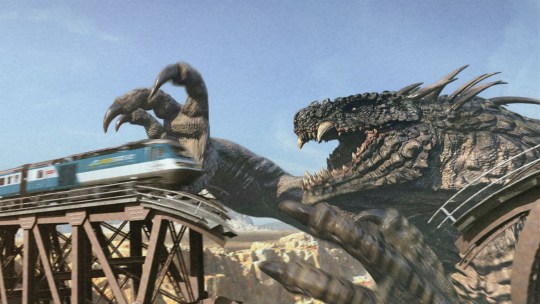
...but then it turned out they just bought the model from TurboSquid and so can you too (link in the source), it’s called “Dino Beast”:
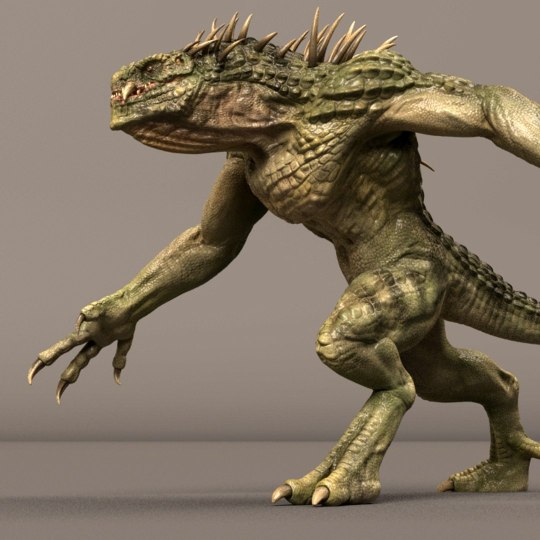
So now they released a sequel to their movie, Ape vs. Mecha Ape, and the design of the titular Mecha Ape is also amazing. Suspiciously so.
youtube
I couldn’t find the model on TurboSquid, but I thought it looked familiar.
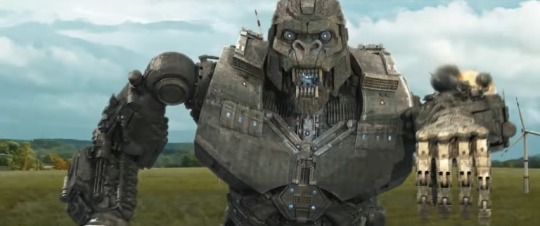
Searching for figures online where I live it’s very common to come across bootlegs, now more than ever with 3D printing technology, some people may get their hands on the file of a model someone else did and either sell the 3d printed figure or the file itself, most likely without the original artist’s knowledge. Add to that the popularity of Godzilla vs. Kong, wich featured a Mechagodzilla, and you come across stuff like this:
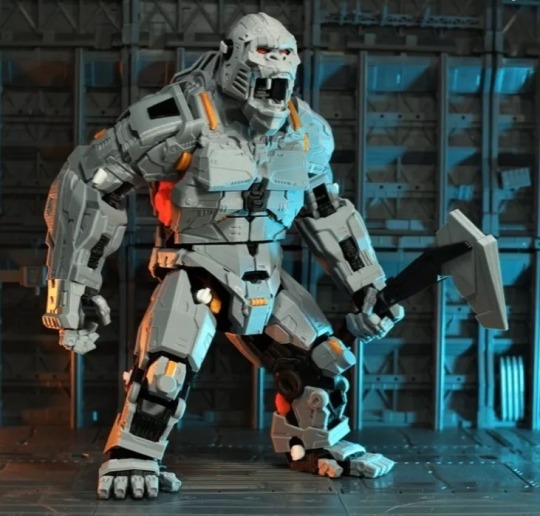
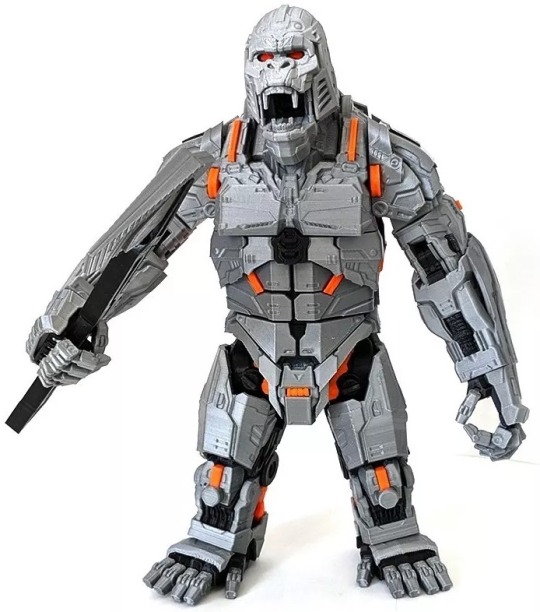
Meet “Mecha King Kong”, as online sellers call it. I assume they won’t call it “Mechanikong” because if you know who that is you probably will know this isn’t an official thing. I can’t find who the original artist is.

Now the bodies look completely different, but the head...
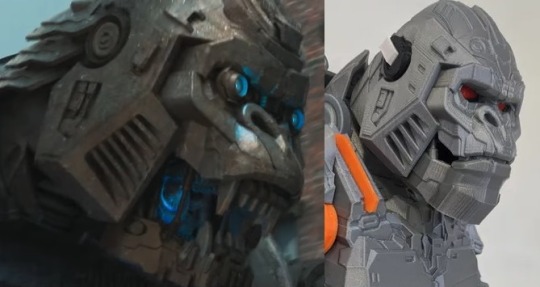
There are some differences, like the eyeballs, the forehead, the jaw, and the lenght of the “airvents”. But many of the details are so similar I simply can’t believe it’s just a coincidence:

Now, if the guys at The Asylum are one thing, it’s legaly savvy. There is a reason they’ve succesfully been in the mockbuster business for DECADES. I’m sure they didn’t steal an asset like these neobootleggers probably did, but I wouldn’t be surprised if the “Mecha Ape” and “Mecha King Kong” 3D models have a common origin somewhere down the line.
If there is something I take from all this unprompted cashing-in on robot gorillas, is that if the Godzilla vs. Kong sequel were to feature a robot Kong (Mechanikong or otherwise), audiences and bootlegers would welcome it with open arms.
(Also is this “Ape” fella going to be their new “Mega Shark”?)
#the asylum#ape vs. mecha ape#ape vs. monster#godzilla vs. kong#kaiju#mecha#king kong#godzilla#mecha king kong#mechanikong#3d printing#mockbuster#godzilla vs kong#z movies#giant monsters#giant robots#long post
231 notes
·
View notes
Note
hi jess! as someone who has never seen a godzilla film, where would you suggest i start to get into the franchise? sorry if this question has been asked a lot, if so then feel free to use this as an excuse to gush about the franchise :3
I think there are some very good places to start with Godzilla. I’m gonna give met recommended starting points here, and then I’ll elaborate under the “view more”
So, my list of Godzilla starting points in no particular order.
Godzilla (2014) - this is a reboot and it’s the beginning of the monsterverse series
Godzilla (1984) - this is a reboot and it’s the beginning of the Hesei era Godzilla series that runs until 1995
Shin Godzilla - a stand alone movie. No sequels to prequels
Godzilla (1954) - it’s the original Godzilla story and it’s good, but I also understand that older movies can be intimidating for newer viewers
Godzilla Against Mechagodzilla - Not to be confused with Godzilla vs Mecha Godzilla, this millennium era Godzilla movie is part of a self contained duology that I personally really enjoy
Now, I’ll explain why I recommend these as staring points bellow:
Godzilla 2014 and Monsterverse
Godzilla (2014) is probably my favorite place to start new fans of Godzilla, even if it’s not my favorite Godzilla movie.
G2014 is the first movie in the Monsterverse series, and there are still Monsterverse projects coming out today. Godzilla X Kong the New Empire is coming soon, and Monarch season 1 is releasing right now. It’s fun to watch something and be a part of something while it’s new and coming out.
I think you will probably enjoy all of the Monsterverse movies, but pay attention to which one you like the most, because it will act as a good indicator of which Godzilla movies to watch next because the Monsterverse movies do a really good job of capturing the tone and feel of different eras of Godzilla movies. It’s like watching through a sampler platter of the entire franchise. G2014 is a beautifully shot cinematic movie that holds its own when compared to the best Godzilla films, while Godzilla King of the Monsters is an action packed monster melee reminiscent of the Hesei era films. Godzilla vs Kong is a campy monster movie that feels like the Showa era films, and Monarch is shaping up to be an introspective look at society that feels in line with the more recent Godzilla projects (shin Godzilla, Singular point, Minus 1).
The monsterverse franchise feels like a love letter to the entire Godzilla franchise, and it makes it the perfect starting point.
Godzilla 1984, and the Heisei continuity
My favorite Godzilla movies are the ones from the Heisei era. Godzilla 1984 was made as a reboot of the franchise, and it’s the start of a solid continuity that lasts until 1995s Godzilla vs Destoroyah. These movies have incredible practical effects and have aged very very well. There are tons of cool monsters and they are just fun. To me this era of Godzilla movies will always be the best, but I also understand that it’s not for everyone.
Shin Godzilla and the Reiwa era
I like Shin Godzilla a lot. It feels like a new philosophical direction for Godzilla as a franchise, while still being respectful of the series roots, but it’s also a hard movie to talk about without spoiling the film. (Don’t worry no spoilers here). Shin Godzilla and its success opened the door for some very interesting projects (like Godzilla singular point, G vs G, Godzilla Minus One and Godzilla earth). I have mixed feelings about some of the Reiwa era Godzilla projects, but I appreciate that they are taking risks with the franchise.
Godzilla 1954 the original
Obviously the original movie was going to be on this list. I think it’s a movie that everyone should see, but I actually don’t think it needs to be the first movie you see. It’s an excellent starting point but I also understand not being in the mood to watch a 70 year old movie. That being said, when you are in the mood for an older movie, you should watch it.
Godzilla Against Mechagodzilla and the millennium era.
After the Heisei Godzilla movies ended they rebooted the franchise again, but instead of starting a new continuity they created a series of stand alone movies that were each in their own continuities. The only exception to this is the two part story of Godzilla Against Mechagodzilla, and Godzilla Tokyo SOS.
You could watch any of the movies from this era without having seen any other Godzilla films, I just happen to like Godzilla Against Mechagodzilla the best. (Godzilla 2000 is a close second).
These are in my opinion the best places to start, but In actuality you can start anywhere. Even the movies with the most continuity around them are pretty stand alone and self contained, so if none of these movies appeal to you then just find one that looks fun and start there
#ask pirateprincessjess#godzilla#I know I haven’t talked about Godzilla Minus one yet#and that’s because I have some thoughts that I need to get organized#because it was a great movie#but there’s also a big problem with it that I haven’t seen people talking about
60 notes
·
View notes
Text
Kaiju Week in Review (January 28-February 3, 2024)
youtube
Minecraft: Bedrock Edition's Godzilla DLC is now available. I joined Wikizilla's stream of it yesterday as a spectator and found it quite entertaining (especially when @squid-in-a-party-hat switched to Creative Mode and started summoning mini-kaiju). I'll post the highlight reel from that stream when it's finished. The main hub of this DLC is a combination movie theater/gallery; each of the four screens lets you access a different minigame. The first is based on the original film and has you rescuing civilians and just trying to survive as Godzilla trashes Tokyo. The second transforms you into Godzilla and pits you and your allies against various kaiju from the first three series. The third tasks you with defending Tokyo against Shin Godzilla, with each defensive phase featuring a different form. The fourth just has you taking photos of the battles in Godzilla vs. Kong (with the Tasmian Sea fight replaced by Godzilla barging into Kong's dome). I found the second and third to be the most interesting, but it's dismaying that only the third really takes advantage of these games being in Minecraft. You scrounge items, build barricades, lay down TNT, trade with NPCs, summon agents, fire blood coagulation potion into Godzilla's mouth from a crossbow... it's a lot more involved than the others.
In further Godzilla video game news, the Heisei MOGUERA and a crystal-hurling SpaceGodzilla variation have joined Godzilla Battle Line, the upcoming Godzilla x Kong: Titan Chasers mobile game is teasing its original monsters, and Dave the Diver of all things announced a free PlayStation-exclusive Godzilla DLC for May.
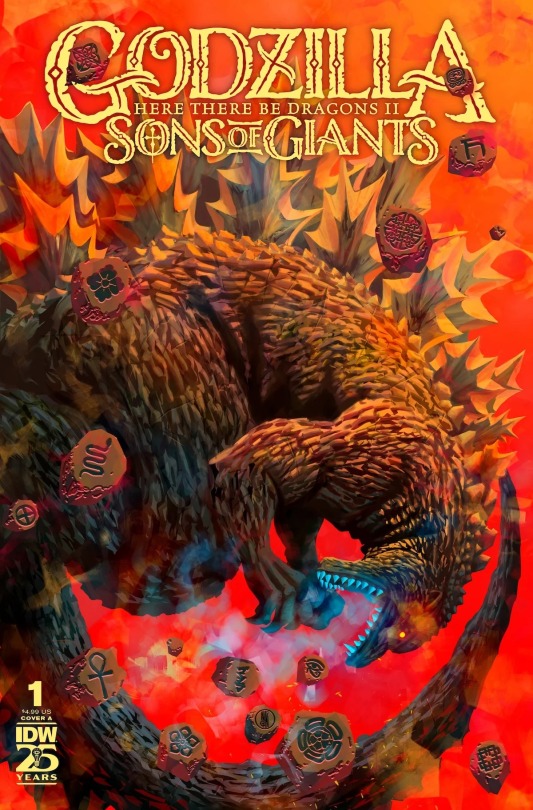
Here's a rare sequel to an IDW Godzilla miniseries. Godzilla: Here There Be Dragons II - Sons of Giants will boast the same writer (Frank Tieri) and artist (Inaki Miranda) as its predecessor. The logline:
The sequel to last summer’s smash miniseries! Frank Tieri and Inaki Miranda reunite to explore the conspiracy that led to Sir Francis Drake hiding his treasure on Monster Island! Who are the Sons of Giants, and what is their mission? More importantly, what is their connection to Godzilla and the other monsters? This series shows us how it all came to be, how Godzilla was discovered by the leaders of the world, and how it changed history forever!
Despite the Roman numerals, sounds like a prequel. I still think there's something off about any Godzilla story set before the Atomic Age, but the Sons of Giants were the most interesting part of the original Here There Be Dragons, and historical figures encountering the King of the Monsters is always amusing.
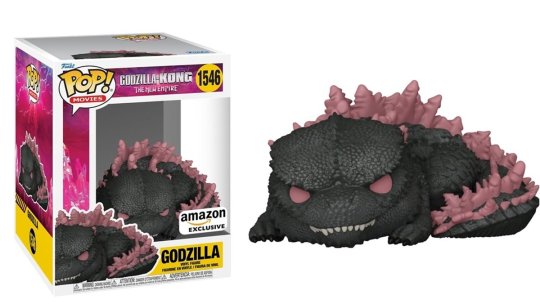
Naturally, Funko is making a line of Pops for Godzilla x Kong: The New Empire. The standout is the Amazon-exclusive figure of a sleeping Godzilla; I also love how Shimo looks like she's yakking. Monogram also revealed the lineup for its sixth wave of Toho Godzilla bag clips, as well as a GxK set. Highlights of the former are a curled-up Final Wars Anguirus, a Simeon, and Zilla; the latter is notable for including a previously-unrevealed monster called a Parrot Frog.
youtube
Tokyo's Hibiya neighborhood has long played host to Godzilla statues: first the Kawakita Godzilla, then Shin. Now they're getting a new three-meter statue of the original '54 Godzilla. It emits smoke at night, the mouth glows, and there seems to be some kind of AR app through which he fires atomic breath at you. Despite it being a 70th anniversary installation, however, it'll only be in Hibiya until March 10. I'm guessing that won't be the last we see of it.
#kaiju week in review#godzilla#toys#minecraft#godzilla here there be dragons ii sons of giants#godzilla x kong the new empire#kaiju
39 notes
·
View notes
Text

Media I’ve Experienced in 2024 (March)
Puella Magi Madoka Magica:Rebellion (8/10)-Big Cake Round Cake Right in Front of Me!
The Little Mermaid 2023 (6/10)-The singing was good besides that wack Awkwafina rap
Craig Before The Creek (8/10)-While I liked Craig of the Creek, I wouldn’t call myself a fan but this prequel was pretty fun into was the main characters were like before
Madame Web (0/10)-No reason to watch, awful effects, bland characters, boring story
Megaman X5 (7/10)-Honestly, the story was kind of stale but the gameplay was still top notch
Peacemaker (9/10)-After playing him in Mortal 1 Kombat, I loved this show. Fun characters, funny dialogue, and some pretty good fights
Megaman X6 (5/10)-Guilty pleasure, while a lot of it was annoyingly hard, I liked the virus stuff and the story
Avenue Q (9/10)-Pretty emotional musical about adulthood despite being played by muppets
Kung Fu Panda 4 (6/10)-Waaay too safe, the villain was intimidating until being defeated in 3 hits
Secrets of the Furious Five (8/10)-Pretty neat special, I liked the Furious Five from their movie screentime and the show and this helped fleshed them out
The Button of Doom (6/10)-While not as good as the movie. This is something Megamind 2 wishes it could be
South Park (8/10)-After 26 Seasons, this show is still pretty good. It has moments that make me laugh while still being shocking and there are characters I find likable to watch like Butters and Kenny
Final Fantasy VII Rebirth (10/10)-Takes my favorite disk of FFVII and expands hard on it. Traversal feels freeing, the locations feel more full, and the story takes some wild turns.
Smiling Friends Season 1 (8/10)-This shows that adult cartoons don’t have to be about nihilism and can be about hope and enjoying life.
Seth MacFarlane’s Cavalcade of Cartoon Comedy (3/10)-While I find Seth MacFarlane funny this didn’t do it for me. The comedy while having decent setups, is ultimately too lazy to make it funny
Megaman X7 (4/10)-Gameplay was repetitive, the voice acting was bad but hey still liked it more than X3
Megaman X8 (8/10)-The gameplay is pretty fun this time, and Lumine is a pretty good villain if they expanded her more
Megaman X:The Day of Sigma (5/10)-The animation is good don’t get me wrong but the pacing couldn’t keep me engaged
Saw (7/10)-Pretty good story about someone who wants to help people realize they want to live by putting them in death traps
Fairy Tail 100 Years Quest Manga (Currently 8/10)-My favorite anime is Fairy Tail and this sequel expands pretty well, the Dragon Gods concept is interesting, the characters are still as they were which is how I like them, and the art during fights are really well detailed
Hello Kitty Super Style (9/10)-I love Supercute Adventures and this show honestly feels like if we got a full 11 minute show.
Mortal Kombat 1995 (8/10)-Fun action and characters. Effects didn’t age the best
Grave of The Fireflies (9/10)-Really emotional movie about those suffering during war
Persona 3 Reload (10/10)-The best gameplay and presentation Persona has ever been.
Godzilla:King of Monsters (9/10)-Really cool action and monsters
King Kong:Skull Island (8/10)-Pretty good story and action
Godzilla 2014 (5/10)-Probably spoiled by how good future Monsterverse but the spectacle was kind of forgettable
Godzilla vs Kong (10/10)-Yup still as fun as I remember it
Hunter X Hunter 2011 (9/10)-As much as I want to strangle Gon the rest of the series is pretty fire
Kaguya Sama Love is War!:The First Kiss That Never Ends (9/10)-Pretty funny and emotional movie
Komi Can’t Communicate (9/10)-Fluttershy as an anime girl
My Senpai Is Annoying (8/10)-I came in wanting Kurobe, left loving Futaba and Takeda
Pokémon Mystery Dungeon:Explorers of Sky-Beyond Time and Darkness (5/10)-The dub is too goofy
OFF The RPG (Opinion Has Changed as of September) (8/10)-Originally I found the fights boring and the fact I was softlocked made it lower. That was a mistake. The story is really haunting and dark, the fights are really basic but not bad, and the locations have an eerie feeling to them
One Piece Film Z (10/10)-Z is a really intimidating villain and the action is pretty good
My Little Pony:The Manga (7/10)-Cute artwork, I wish the stories were better
#review#tier list#march 2024#my senpai is annoying#komi can't communicate#one piece#godzilla#king kong#my little pony#fairy tail#fairy tail 100 years quest#megaman#megaman x#off game#craig of the creek#craig before the creek#avenue q#hunter x hunter#hunter x hunter 2011#smiling friends#puella magi madoka magica#madoka magica#mortal kombat#saw franchise#kung fu panda#kung fu panda 4#megamind#south park#madame web#video games
8 notes
·
View notes
Text
SORRY who was going to tell me that the sequel to “Godzilla vs. Kong” is called “Godzilla x Kong”??? Like it’s a ship name?? They team up????? Enemies-to-lovers?
11 notes
·
View notes
Text

Finished watching Gamera Rebirth last night, and boy was that fun!
Was it perfect? No. There are some nits I could pick. But just like the ones I had with Godzilla Singular Point (2021), they did not affect my enjoyment of the series at all.
I loved that the series incorporated elements from all three eras of Gamera, including the criminally under-appreciated Gamera the Brave (2006). The kaiju redesigns were sick, the fights were even sicker, and Gamera took some heavy damage and still managed to defeat all the bad guys.
Okay, one detail I really didn't like: Gamera being suddenly so powerful that he can fire a beam to take out a target on the moon. It was just as ridiculous as when Godzilla used his breath to blast a hole to the center of the Earth in Godzilla vs. Kong (2021) (then again, that whole dang film was ridiculous; ridiculously bad, that is!).
The production team almost completely made up for that, however, by playing an instrumental version of the Gamera song over the end credits. That was an awesome touch!
I'm glad they kept things open for a sequel series, which I'm hoping we'll see someday. We (speaking for me, myself, and I) need more Gamera in our lives. And I'll take another Gamera animé series of this caliber any day.
Or at least until someone gets around to making some more live-action films.
44 notes
·
View notes
Text
Titans Clash Again In Godzilla X Kong: The New Empire
Godzilla X Kong: The New Empire is a visual spectacle that takes us back to the late Showa era. Director Adam Wingard has crafted a vibrant, action-packed adventure that, while it may have its flaws, delivers on the promise of monstrous entertainment.
The film is a direct sequel to 2021’s Godzilla vs. Kong and continues the tradition of the Monsterverse franchise. This time, we see the almighty Kong and the fearsome Godzilla pitted against a colossal undiscovered threat hidden within our world. The narrative is fragmented and knowingly silly, cross-cutting between lines of action in multiple locations that all lead to a huge showdown with a lot of creatures.
While the human characters may feel one-dimensional and the script weak, the film is all about the action. The special effects are inconsistent, and the editing can be shoddy at times. However, the film does not shy away from its identity as a fun popcorn film.
The film delves further into the histories of these Titans, their origins, and the mysteries of Skull Island and beyond. It uncovers the mythic battle that helped forge these extraordinary beings and tied them to humankind forever.
Godzilla X Kong: The New Empire is a textbook visual thrill ride punctuated by brief moments of forced emotion and little else. It may be all over the place, but it gives fans the over-the-top monster action that they demand via an imposing new villain.




#godzilla x kong: the new empire#monsterverse#adam wingard#movie review#film critique#godzilla#king kong
7 notes
·
View notes
Text
Why The Monsterverse Doesn't Feel Right to Me (not that I mind)
Honestly, as much as I tend to harp on about the Monsterverse for better or worse, I don't really hate the Godzilla and Kong movies anymore. They're made for fun, people had fun, and that's really all you can ask for at the end of a movie.
The only real complaint I have is how I would have liked to see what the sequels would have been like if WB stuck with Edwards and that moody, foreboding atmosphere or the Nolan Batman-esque direction they had before Kong came in. Or better yet if they just made them into their own thing.
The worldbuilding of the Monsterverse is more likely to drive you to madness than anything Lovecraft came up with and each movie just adds a new weird wrinkle to the "literal-mythology-meets-hollywood-ecology" angle they've taken.
But the most frustrating thing is how every time Godzilla movies get rebooted to try taking themselves more seriously, there's always a cause-effect relationship between fans demanding more monster fights and the studios doubling down on making crowd pleasers to boost the box office results.
Sure that's par for the course in Hollywood, but that goes for Toho's own stuff too. Just look at the mood swings before The Return of Godzilla (1984)!
To put it in the ever popular superhero movie terms, imagine if Superman Returns' success turned The Nolan Batman trilogy into something campier and... well, that already sorta happened back in the 90s after Batman Returns, didn't it?
So let's imagine if after The Nolan Batman movies, WB decided that next Superman movie should be more grittier, darker--oh no wait, that already happened too.
Alright, then let's say Legendary made a Pacific Rim sequel but instead of the grungy underdog story GDT did they made it into a totally cliched blockOH GODDAM IT--
(Hmm... It's starting to feel like radical shifts in the quality and production of genre films in an attempt to become more profitable via mass appeal is standard practice for Hollywood...)
Well, all I'm saying is as far as future Kong reboots and western adaptations of Godzilla go, maybe we should just give cinematic universes a break and either do what Alien vs. Predator did.
Or better yet, hope Toho lets whoever gets the license next to take after the new WB-DC movies and find the right balance with solo movies and team-ups.
#i also think we should at least consider asking matt reeves if he likes godzilla after he's done with the other The Batman#ramblings of the critter#godzilla#kong#godzilla vs kong#godzilla x kong the new empire#(not tagging this as godzilla x kong only so that I don't look like I'm queerbaiting or trying to flood the tags)#monsterverse#kaiju#giant monsters#meta#warner bros#hollywood
7 notes
·
View notes
Text
Happy Birthday 🎂 🥳 🎉 🎈 🎁 🎊 To A Very Prominent Uprising Young British👩 🇬🇧 Actress Of This Century.
She is a Child Prodigy & Most Very Well Talented Young Actress Of Today's Age
Born In Marbella, Málaga, Spain, on 19 February 2004, the third of four children born to British parents Kelly and Robert Brown, an estate agent. She was born with partial hearing loss in her left ear. She moved with her family back to England when she was four, settling in Bournemouth; when she was eight, the family moved to Orlando, Florida.
In 2016
She was cast to play The Most Prominent Role Of Her Acting Career As a Child Star
She Was Cast To Play Eleven in the Netflix science fiction horror series
Stranger Things.
She received critical praise for her performance and she was nominated for the Screen Actors Guild Award for Outstanding Performance by a Female Actor in a Drama Series and the Primetime Emmy Award for Outstanding Supporting Actress in a Drama Series. She then won the Screen Actors Guild Award for Outstanding Performance by an Ensemble in a Drama Series with her co-stars and won the 43rd Saturn Award for Best Performance by a Younger Actor in a Television Series. For her role as Eleven in the second season of Stranger Things, she received her second nominations for a Screen Actors Guild Award and a Primetime Emmy Award in 2018.
In 2018, she was named one of the 100 most influential people in the world by Time magazine, becoming the youngest person to be included in the list. In addition she was named by Time magazine as one of the most influential teens of 2017 and of 2018. That year, she become the youngest person ever to be appointed a UNICEF Goodwill Ambassador. EA Games announced that She collaborated with The Sims 4 programmers to feature in the Sims 4 Positivity Challenge. In 2018, The Hollywood Reporter ranked She as among Hollywood's top thirty stars under age eighteen.
She made her feature film debut in 2019, in Godzilla: King of the Monsters, the sequel to the 2014 film Godzilla. She reprised her role in the next sequel, Godzilla vs. Kong (2021). She became the ambassador of UEFA's Together #WePlayStrong campaign. In 2019, She launched "Florence by Mills", her own beauty product line. It is available at UK pharmacy Boots, Walmart in the United States, and Shoppers Drug Mart in Canada. In 2020, She starred in and produced the film adaptation of The Enola Holmes Mysteries.
In 2022, She earned $10 million to reprise her role as Enola Holmes in the sequel, Enola Holmes 2. Also that year, she was made an ambassador of the fashion brand Louis Vuitton.
She will next star and executive produce the fantasy film Damsel for Netflix, under the direction of Spanish filmmaker Juan Carlos Fresnadillo based on a screenplay by Dan Mazeau. She will also star in the Russo brothers's The Electric State, an adaptation of Simon Stålenhag's graphic novel of the same name.
Please Wish This Young & Rising Actress Of British Acting A Very Happy Birthday 🎂 🥳 🎉 🎈 🎁 🎊
You Know Her & You Just Gotta Love Her.
This Prodigal Child Of TV & Now Big Blockbuster Movies. Now All Grown Up
The 1 & The Only
Ms. Milllie Bobby Brown 👩🇬🇧 Aka Eleven Of Netflix's STRANGER THINGS 😈 Millie Bobby Brown
Happy 21st Birthday 🎂 To You Ms. Brown 🇬🇧 & Here's To Many More Years To Come.

#MillieBobbyBrown #Eleven #StrangerThings #GodzillaKingOfTheMonsters #EnolaHolmes #GodzillaVsKong #Damsel
#Millie Bobby Brown#Eleven#Stranger Things#Godzilla King Of The Monsters#Enola Holmes#Godzilla Vs Kong#Damsel#Spotify
2 notes
·
View notes
Text
YET ANOTHER KAIJU FILM REC LIST
(Selected and arranged to account for modern tastes, as well as to highlight specific wants for fans of Godzilla: Minus One and/or Godzilla x Kong: The New Empire)
Notes:
Titles can be confusing, when in doubt differentiate films by year of release
"Showa" generally refers to films made from 1954-1980, while "Heisei" generally refers to films made from 1984-2006, with "Millennium" being a specific series of Godzilla films made from 1999-2004, within the Heisei era (the actual notation refers to the Japanese Emperor, but this is slightly offset with how it's used for kaiju films)
I've tried to list where the films can be watched, for free if possible, but this can change at a moment's notice (for instance, the TokuSHOUTsu Youtube channel currently has a livestream of almost all the Showa Godzilla films and one for the MST3K episodes featuring 6 Showa Gamera films and Gorgo, but I have no idea how long those will stay up)
More context and history about the kaiju film genre can be found at the end of the post
GROUP 1: EVERYONE
These films are the peers and equals of Minus One and GxK, in only the best respects.
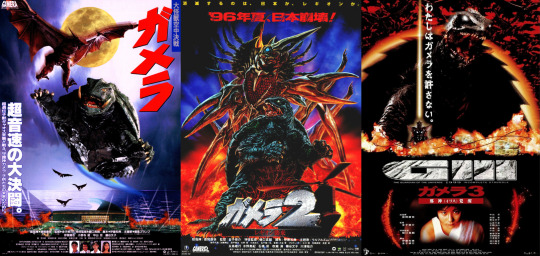
The Gamera Heisei Trilogy - Gamera: Guardian of the Universe (1995), Gamera 2: Attack/Advent of Legion (1996), and Gamera 3: Revenge/Awakening of Iris (1999)
I would recommend this trilogy to ANYONE - even those hesitant to watch anything that isn't CGI, or that still don't think kaiju films can be good cinema. No matter what you're looking for in a kaiju film - engaging monster action, compelling human drama, deep metaphorical significance, fun action-adventure, hard sci-fi, spiritual eastern fantasy - these three movies are bound to be among the best at it. They're nearly unanimously praised as some of the best kaiju films of all time, and are the ONLY classic films with that honor that can visually compete with modern tastes in special effects.
Among the three: Guardian of the Universe is probably the closest analog to GxK, a fun action-adventure film about a girl who communicates with a giant monster. Revenge of Iris is closer to Minus One, introducing a darker mirror of the first film's story that invokes trauma and loss to great emotional impact. Which all leaves Advent of Legion in the middle, as a fairly formulaic but well-executed sci-fi alien invasion story.
These films are available free and subtitled on Tubi, or free and dubbed on Pluto. In a rarity, the dubs are done with love and care by fans of the genre and while they may not be the best way to watch the films, they're fairly decent.
GROUP 2: MODERN/NICHE
These films either excellently or acceptably compete with modern visual effects, but in other areas, are ultimately more dependent upon viewer tolerances and niche interests.
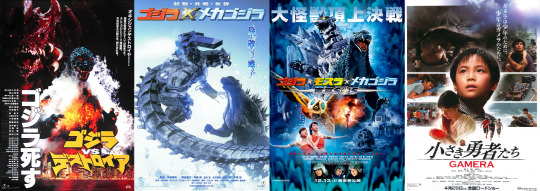
Godzilla vs. Destoroyah (1995)
If you want to cry about Godzilla, this is it, this is the movie. Possibly the classic film that delves the deepest into the idea of kaiju as sympathetic, tragic beings, this film leans heavily into hard sci-fi and features a kaiju opponent inspired by the titular creature from the Alien franchise. It's the seventh film in the Godzilla Heisei series, but as most of the previous films are currently stuck behind rights issues and difficult to find, I'd recommend jumping into this one as a standalone (or, if anything, watch the original 1954 Godzilla film first, but if that doesn't interest you it's not necessary). This movie is readily available for free, subtitled on Pluto or dubbed on Youtube.
The Kiryu Duology - Godzilla Against Mechagodzilla (2002) and Godzilla: Tokyo S.O.S. (2003)
These two films face a number of pacing and production issues, and due to scheduling conflicts, the main heroine, mech pilot Akane from the first film (arguably one of the most compelling human characters in the entire Godzilla series), was unable to return for the sequel beyond a brief cameo. But despite feeling unfinished, not all the emotional weight of this duology is lost. The ethics-focused, techno-spiritual story being told still packs a punch, and visually, out of the entire suitmation era this is the best Godzilla, Mothra, and Mechagodzilla have ever looked on-screen. If first checking out the original 1954 Godzilla and the 1961 Mothra interests you at all, it may enhance the viewing experience, but if not, dive right in! Both these films are free on Pluto TV, but do keep in mind Against Mechagodzilla is the dubbed version.
Gamera the Brave (2006)
I've said it before, but this is the movie that most closely reminds me of Minus One, with its modern filmmaking style, deep emotional themes, and in particular, having a bright and hopeful appeal to humanity in a genre where many of the more serious films are tragedies. Personally I rank this one right up there with the 90s Gamera trilogy, if not even higher, but to appreciate it, you really do have to be here for a children's fantasy film with more charm and heart than fast-paced kaiju action. This film is free on Tubi, subtitled.
GROUP 3: CLASSIC
These films require a tolerance for the special effects of the 1950s through 1970s, which I realize some modern audiences may find difficult to appreciate, but are otherwise highly recommended.
All four of these films are available free and subtitled on Pluto through Criterion, and are additionally part of SHOUT! Factory's catalogue and playing on the livestream.

Godzilla (1954)
If you've seem Minus One or Shin Godzilla, the obvious route is, of course, to go back to 1954 and experience the original cinematic masterpiece of Godzilla as a nuclear horror. The one caveat I'll mention is that a lot of Minus One's effectiveness is in subverting one theme present in the original, so this will, in a way, feel like a step backward thematically.
Ebirah, Horror of the Deep (1966)
The outright most comparable classic film to GxK - a fun island adventure film wherein various entertaining personalities are shipwrecked and must work together to thwart human baddies and even recruit the help of Godzilla! This is one of my personal favorites, and while Mothra only appears briefly in the film, it expands on her lore quite a bit.
Godzilla vs. Hedorah (1971)
This film is wacky, resembling an abstract art house film at times, but in many ways is a revisitation upon the dark, deep metaphors of the original, this time warning of the dangers of pollution through a truly terrifying monstrosity that gives Godzilla one of the most brutal fights of his career.
Terror of Mechagodzilla (1975)
Along with the original and Hedorah, this completes a trio of more dark and serious Showa era Godzilla films. It's the only Godzilla movie of its era to be written entirely (not co-written) by a woman, tells a dark and tragic tale, and yet is the height of 1970s superhero Godzilla as he takes on two powerful opponents at once.
GROUP 4: GRAB BAG
I'll throw in four more: these are just some of my personal recommendations and favorites that don't fit neatly into the other categories.
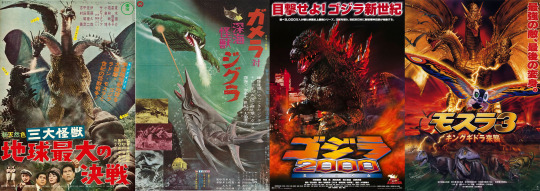
Ghidorah, the Three-Headed Monster (1964)
The original and archetypical "multiple monsters team up to fight a greater threat" movie. This one is consistently on the edge of being called an objectively good film, but can be considered too cheesy and campy to make the cut. Nonetheless, it's a fun time, and it's also pretty much the only classic film where Godzilla and Mothra interact positively, if that's appealing to you. Like the other Showa Godzilla films, it's free through Pluto and SHOUT! Factory.
Gamera vs. Zigra (1971)
I really just wanted to put a Showa Gamera here, and this is one of my favorites. Just the campy, wacky, good time that is Showa Gamera, with a side of ocean theming - this extremely cheap film was partly funded through Kamogawa Sea World, which is the primary location featured in the film. It's free on Tubi along with the other Gamera films, and also makes a great MST3K episode, even if the version of the film used there is very low-resolution and the underwater scenes in particular suffer a little.
Godzilla 2000: Millennium (1999)
Somewhat unique among its contemporaries for being a 2000s era film that features Godzilla as more-or-less the protagonist, with human characters that advocate for understanding and respecting him. It's an incredibly cinematic film - I would describe its special effects as ambitious, not always effective, but regardless it would be a great intro for new fans if it were more accessible. Currently, it's tough to track down, but another rare case where the heavily-edited US dubbed version is perfectly acceptable, and even sometimes considered superior to the original.
Rebirth of Mothra 3 (1998) and to an extent, the whole trilogy.
I unashamedly love these oft-maligned films that are actually very comparable to the Heisei Gamera trilogy... in all respects but objective quality. Fun fantasy kaiju films featuring tiny women who fight each other with swords and flying mounts, while a superpowered giant moth beats up two space dragons and takes a break in the middle to beat up a genetically-engineered dragon. Lots of rainbows and lasers, and a vague, underlying exploration of the conflict between those with peaceful methods and those with violent methods without completely villainizing either side. If any of that sounds interesting, check these films out, they're currently readily available free on Pluto after a long history of the third and most serious/mature film being extremely rare and seldom-seen.
FURTHER NOTES AND CONTEXT:
Inspired by western giant monster films like King Kong and The Beast from 20,000 Fathoms, and the summation of Japan's nuclear fear and trauma, the original Godzilla film in 1954 was a runaway success, beginning the kaiju genre as production company Toho ordered not only a direct sequel, but a broad scope of special effects films that ultimately gave us other classic kaiju like Mothra and Rodan.
In the 1950s and 1960s, the concept of a "Godzilla series" did not yet exist - Toho just made science fiction films, wherein some of them featured kaiju, and some of those, but not all, featured Godzilla. Many of these films were very loosely, and sometimes only retroactively, considered to be in the same universe or cinematic canon, creating situations where kaiju like Manda and Baragon would wander into Godzilla films after getting their start in non-Godzilla adventures like Atragon (1963) and Frankenstein vs. Baragon (1965). (An example of a non-kaiju Toho film I would highly recommend is 1958's H-Man)
The 1960s also saw a "Kaiju Boom," where the genre was expanded beyond Toho to other studios in Japan and even to other countries. This brought about a number of new kaiju projects like Gorgo (1961), Reptilicus (1961), and Yongary, Monster from the Deep (1967). The only of these films to be successful enough to spawn a series was Gamera (1965), from Daiei studios in Japan, and there were 7 Gamera films made from the mid-60s to early 70s. (Daiei has their own catalogue of Toku effects films, and also produced the kaiju-adjacent Daimajin trilogy (1966), period pieces set in ancient Japan about a giant warrior statue that comes to life)
Interest in kaiju films began to wane in the 1970s, and Toho largely narrowed its focus to a yearly Godzilla series with lower and lower budgeting. Godzilla vs. Megalon (1973) was the most cheeply-made of these, but several factors made it the most widely-known film in the US and solidified the genre's "rubber suits and cardboard buildings" reputation among the general public for the next 50 years. Also in 1973, Toho produced the giant hero television series Zone Fighter, where Godzilla, King Ghidorah, and Gigan appear in several episodes. The series was made to compete with Ultraman and other television-based Tokusatsu, which was swaying audiences away from films at the time. (I personally know very little about Ultraman and other costumed hero Toku, but I know there are many experts on here who could answer questions about those)
Toho continued to make science fiction and effects films throughout the late 70s and 1980s, such as The War in Space (1977), but kaiju films were out of fashion. Gamera had a brief pseudo-revival in 1980, but otherwise it was a long drought from 1975 to 1984, when Toho began the Godzilla Heisei series: a series of seven films that continued in 1989 and picked up to a film per yer from 1991 to 1995. These films featured more strict continuity and the recurring character of Miki Saegusa, marking one of the first steps away from the previous practice of switching out the human cast entirely from film to film.
In the late 90s, Godzilla was absent yet again, as Toho made the rights handoff to Sony for the 1998 American film. In his place were the competing late 90s Gamera and Mothra trilogies, both relatively unique in featuring multiple recurring cast members and worlds that blended sci-fi and fantasy elements. In America, the poorly-received GODZILLA (1998) spawned a more warmly-recieved animated continuation in Godzilla: the Series (1998-2000).
In response to the critical failure of the 1998 film, Toho craved redemption and launched the Millennium Series: six Godzilla films that, with the exception of the Kiryu Duology, were all standalone in hopes of attaining theatrical releases in the US (only Godzilla 2000 succeeded at this). With a general failure of the 50th anniversary film Godzilla: Final Wars (2004), Toho put Godzilla to rest, seemingly for good. Gamera the Brave in 2006 was the last true suitmation kaiju film, critically acclaimed but also a financial failure.
In the intervening decade, CGI took over, and was the name of the game by the time Pacific Rim (2013), Godzilla (2014), and Shin Godzilla (2016) kicked off the new "Kaiju Renaissance," the present era that includes Reiwa Godzilla and the Monsterverse.
7 notes
·
View notes
Text
Tiny Review: Godzilla x Kong: The New Empire 2024. Violent kids show.
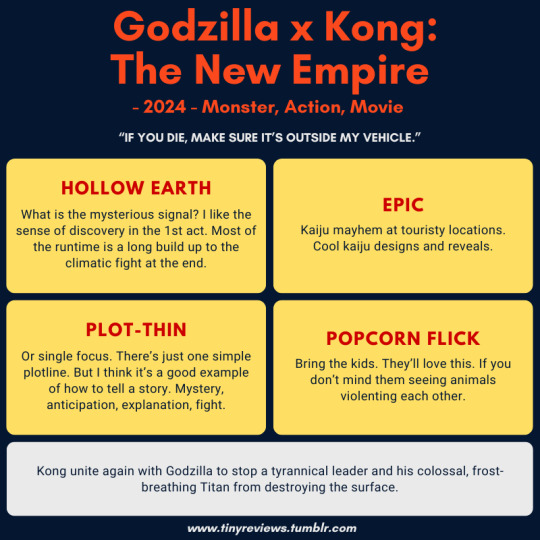
There’s a thin theme of parenting. With the relationship of Ilene and Jia on the line, and the lone ape and cub scenes. It’s all cursory to final fight.
The closing mom-daughter moment could have hit harder, more emotional, imo.
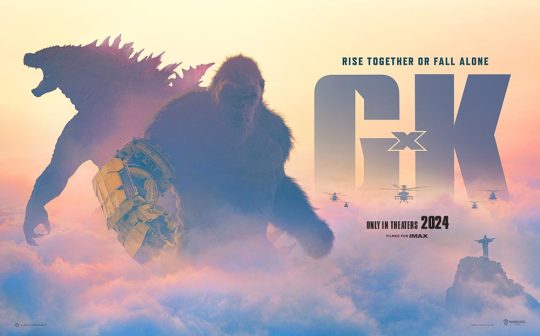
Godzilla x Kong: The New Empire is a 2024 American monster film directed by Adam Wingard. It is the sequel to Godzilla vs. Kong (2021) and stars Rebecca Hall, Brian Tyree Henry, Dan Stevens, Kaylee Hottle, Alex Ferns, and Fala Chen.
#kong x godzilla#king kong#godzilla#hollow earth#monarch#mothra#godzilla x kong: the new empire#monster movies#rebecca hall#brian tyree henry#dan stevens#kaylee hottle#alex ferns#fala chen#2024 movies#movie review#gxk#gxk: the new empire#kaiju#kaiju movies
13 notes
·
View notes